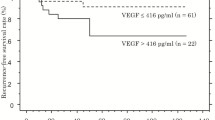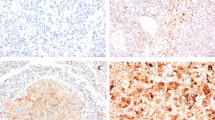Abstract
Purpose
We investigated the expression status of vascular endothelial growth factor (VEGF), platelet-derived growth factor (PDGF)-B and their receptors in organ-confined clear cell renal cell carcinoma (ccRCC) to evaluate their prognostic significance after radical surgery.
Methods
In 758 consecutive patients diagnosed with pT1-2N0 ccRCC between 2007 and 2012, we prospectively investigated the expression levels of VEGF, PDGF-B, VEGF receptor (VEGFR) and PDGF receptor (PDGFR)-β via immunohistochemistry. Clinicopathologic parameters and expression of the angiogenic factors were analyzed with respect to recurrence-free survival (RFS) after nephrectomy. The median follow-up was 29.5 months (IQR 21.5, 39.6) after surgery.
Results
Partial nephrectomy had been performed in 48.5 % of the patients, and tumors were staged as pT1a in 514 (67.8 %), pT1b in 192 (25.3 %) and pT2 in 52 (6.9 %). VEGF, PDGF and their receptors were identified in the cytoplasm and membranes of the tumor cells. Expression level of VEGFR inversely correlated with both tumor size (r = −0.076, p = 0.014) and nuclear grade (r = −0.297, p = 0.004). As for PDGF-B, the expression level showed an inverse correlation with tumor size (r = −0.216, p < 0.001) while PDGFR-β inversely correlated with nuclear grade (r = −0.341, p = 0.001). On multivariate analysis, age, pathologic stage, nuclear grade and PDGFR-β expression (high vs. low or none, HR 3.121 95 % CI 1.300–7.493, p = 0.011) were independently prognostic of RFS after nephrectomy.
Conclusions
In organ-confined ccRCC, high expression of PDGFR-β was independently predictive of poorer RFS after nephrectomy.


Similar content being viewed by others
References
Amin MB, Amin MB, Tamboli P et al (2002) Prognostic impact of histologic subtyping of adult renal epithelial neoplasms: an experience of 405 cases. Am J Surg Pathol 26(3):281–291
Bergers G, Benjamin LE (2003) Tumorigenesis and the angiogenic switch. Nat Rev Cancer 3(6):401–410
Cao Y (2013) Multifarious functions of PDGFs and PDGFRs in tumor growth and metastasis. Trends Mol Med 19(8):460–473
Darwish OM, Kapur P, Youssef RF et al (2013) Cumulative number of altered biomarkers in mammalian target of rapamycin pathway is an independent predictor of outcome in patients with clear cell renal cell carcinoma. Urology 81(3):581–586
Delahunt B, Kittelson JM, McCredie MR, Reeve AE, Stewart JH, Bilous AM (2002) Prognostic importance of tumor size for localized conventional (clear cell) renal cell carcinoma: assessment of TNM T1 and T2 tumor categories and comparison with other prognostic parameters. Cancer 94(3):658–664
Dirim A, Haberal AN, Goren MR et al (2008) VEGF, COX-2, and PCNA expression in renal cell carcinoma subtypes and their prognostic value. Int Urol Nephrol 40(4):861–868. doi:10.1007/s11255-008-9362-7
Fuhrman SA, Lasky LC, Limas C (1982) Prognostic significance of morphologic parameters in renal cell carcinoma. Am J Surg Pathol 6(7):655–663
Gerber HP, Hillan KJ, Ryan AM et al (1999) VEGF is required for growth and survival in neonatal mice. Development 126(6):1149–1159
Gilbert SM, Whitson JM, Mansukhani M et al (2006) Detection of carbonic anhydrase-9 gene expression in peripheral blood cells predicts risk of disease recurrence in patients with renal cortical tumors. Urology 67(5):942–945
Heldin CH, Westermark B (1999) Mechanism of action and in vivo role of platelet-derived growth factor. Physiol Rev 79(4):1283–1316
Jemal A, Siegel R, Ward E, Hao Y, Xu J, Thun MJ (2009) Cancer statistics, 2009. CA Cancer J Clin 59(4):225–249. doi:10.3322/caac.20006
Karakiewicz PI, Jeldres C, Suardi N et al (2008) Age at diagnosis is a determinant factor of renal cell carcinoma-specific survival in patients treated with nephrectomy. Can Urol Assoc J 2(6):610–617
Kim WY, Kaelin WG (2006) Molecular pathways in renal cell carcinoma–rationale for targeted treatment. Semin Oncol 33(5):588–595
Kim HL, Seligson D, Liu X et al (2004) Using protein expressions to predict survival in clear cell renal carcinoma. Clin Cancer Res 10(16):5464–5471
Komai Y, Fujii Y, Iimura Y et al (2011) Young age as favorable prognostic factor for cancer-specific survival in localized renal cell carcinoma. Urology 77(4):842–847
Lidgren A, Hedberg Y, Grankvist K, Rasmuson T, Vasko J, Ljungberg B (2005) The expression of hypoxia-inducible factor 1alpha is a favorable independent prognostic factor in renal cell carcinoma. Clin Cancer Res 11(3):1129–1135
Moch H, Gasser T, Amin MB, Torhorst J, Sauter G, Mihatsch MJ (2000) Prognostic utility of the recently recommended histologic classification and revised TNM staging system of renal cell carcinoma: a Swiss experience with 588 tumors. Cancer 89(3):604–614
Muramaki M, Miyake H, Sakai I et al (2011) Age at diagnosis as a powerful predictor for disease recurrence after radical nephrectomy in Japanese patients with pT1 renal cell carcinoma. Int J Urol 18(2):121–125. doi:10.1111/j.1442-2042.2010.02683.x
Nicol D, Hii SI, Walsh M et al (1997) Vascular endothelial growth factor expression is increased in renal cell carcinoma. J Urol 157(4):1482–1486
Novara G, Martignoni G, Artibani W, Ficarra V (2007) Grading systems in renal cell carcinoma. J Urol 177(2):430–436. doi:10.1016/j.juro.2006.09.034
Ostman A, Heldin CH (2007) PDGF receptors as targets in tumor treatment. Adv Cancer Res 97:247–274
Pantuck AJ, Zisman A, Belldegrun AS (2001) The changing natural history of renal cell carcinoma. J Urol 166(5):1611–1623
Park BK, Kim CK, Park SY, Shen SH (2013) Percutaneous radiofrequency ablation of renal cell carcinomas in patients with von Hippel Lindau disease: indications, techniques, complications, and outcomes. Acta Radiol 54(4):418–427
Rajandram R, Yap NY, Pailoor J et al (2014) Tumour necrosis factor receptor-associated factor-1 (TRAF-1) expression is increased in renal cell carcinoma patient serum but decreased in cancer tissue compared with normal: potential biomarker significance. Pathology 46(6):518–522. doi:10.1097/PAT.0000000000000145
Rioux-Leclercq N, Fergelot P, Zerrouki S et al (2007) Plasma level and tissue expression of vascular endothelial growth factor in renal cell carcinoma: a prospective study of 50 cases. Hum Pathol 38(10):1489–1495
Scoll BJ, Wong YN, Egleston BL, Kunkle DA, Saad IR, Uzzo RG (2009) Age, tumor size and relative survival of patients with localized renal cell carcinoma: a surveillance, epidemiology and end results analysis. J Urol 181(2):506–511
Sulzbacher I, Birner P, Traxler M, Marberger M, Haitel A (2003) Expression of platelet-derived growth factor-alpha alpha receptor is associated with tumor progression in clear cell renal cell carcinoma. Am J Clin Pathol 120(1):107–112
Tawfik OW, Kramer B, Shideler B, Danley M, Kimler BF, Holzbeierlein J (2007) Prognostic significance of CD44, platelet-derived growth factor receptor alpha, and cyclooxygenase 2 expression in renal cell carcinoma. Arch Pathol Lab Med 131(2):261–267
Tsui KH, Shvarts O, Smith RB, Figlin RA, deKernion JB, Belldegrun A (2000) Prognostic indicators for renal cell carcinoma: a multivariate analysis of 643 patients using the revised 1997 TNM staging criteria. J Urol 163(4):1090–1095 quiz 1295
Author information
Authors and Affiliations
Corresponding author
Ethics declarations
Conflict of interest
The authors made no disclosures.
Rights and permissions
About this article
Cite this article
Shim, M., Song, C., Park, S. et al. Prognostic significance of platelet-derived growth factor receptor-β expression in localized clear cell renal cell carcinoma. J Cancer Res Clin Oncol 141, 2213–2220 (2015). https://doi.org/10.1007/s00432-015-2019-x
Received:
Accepted:
Published:
Issue Date:
DOI: https://doi.org/10.1007/s00432-015-2019-x




